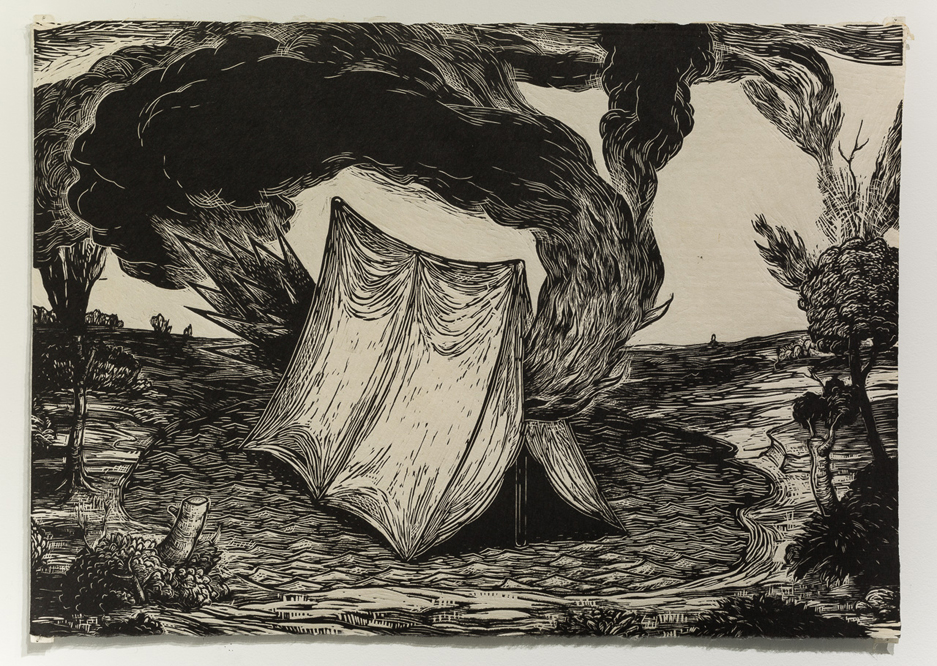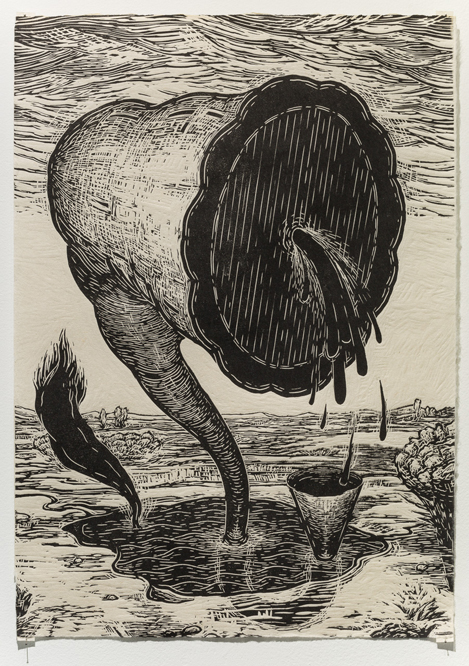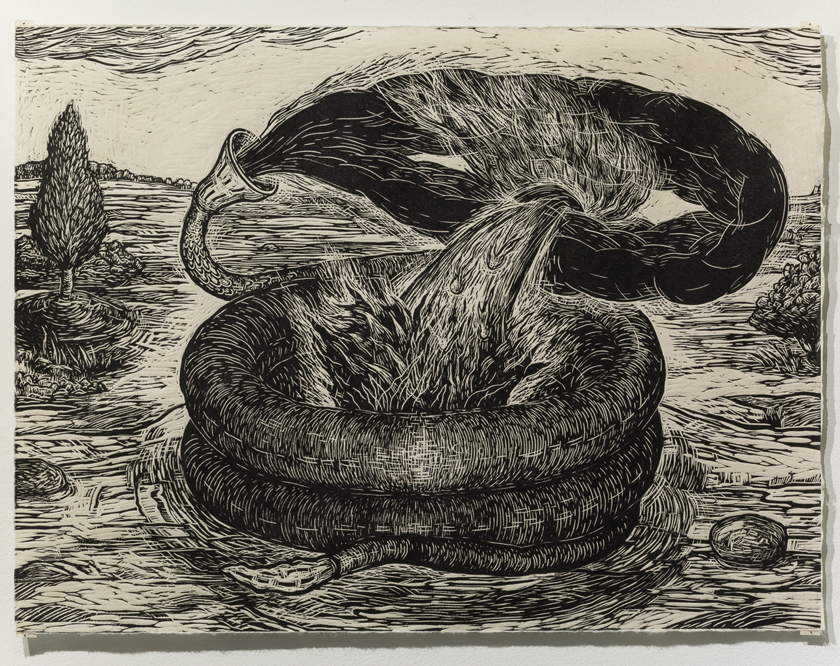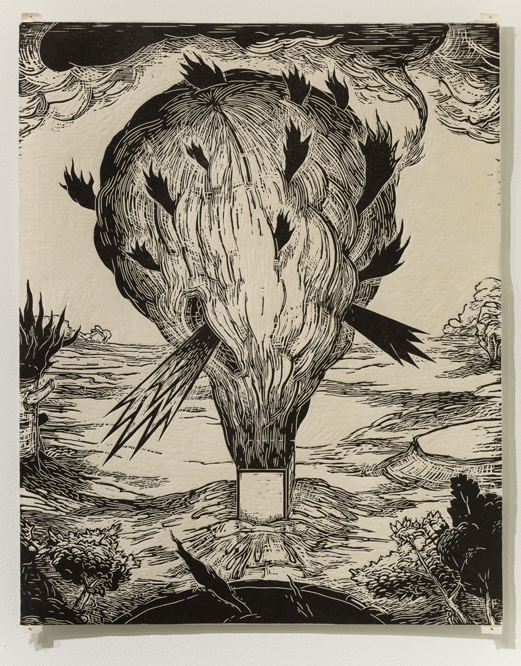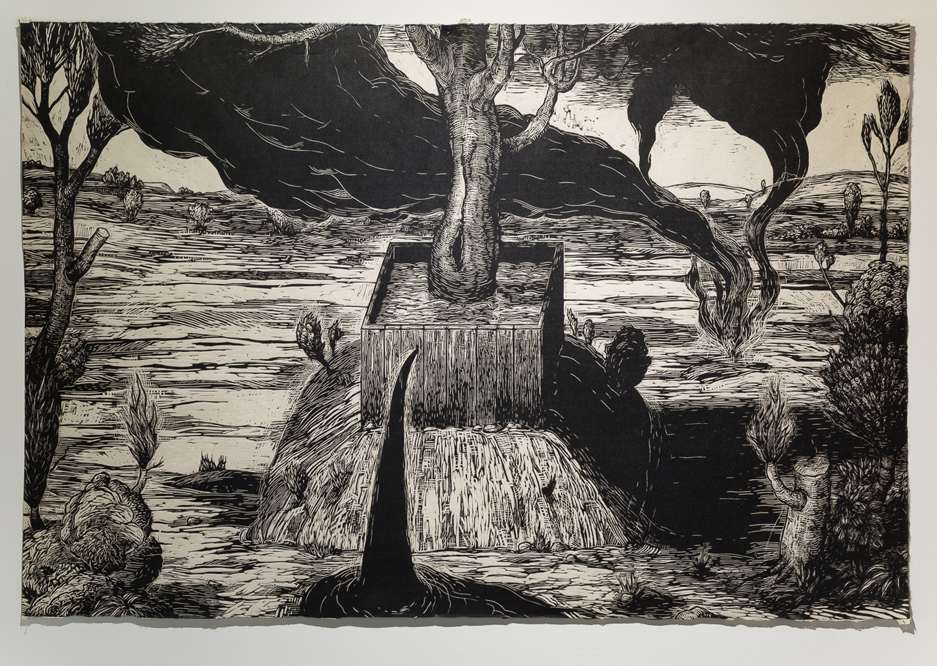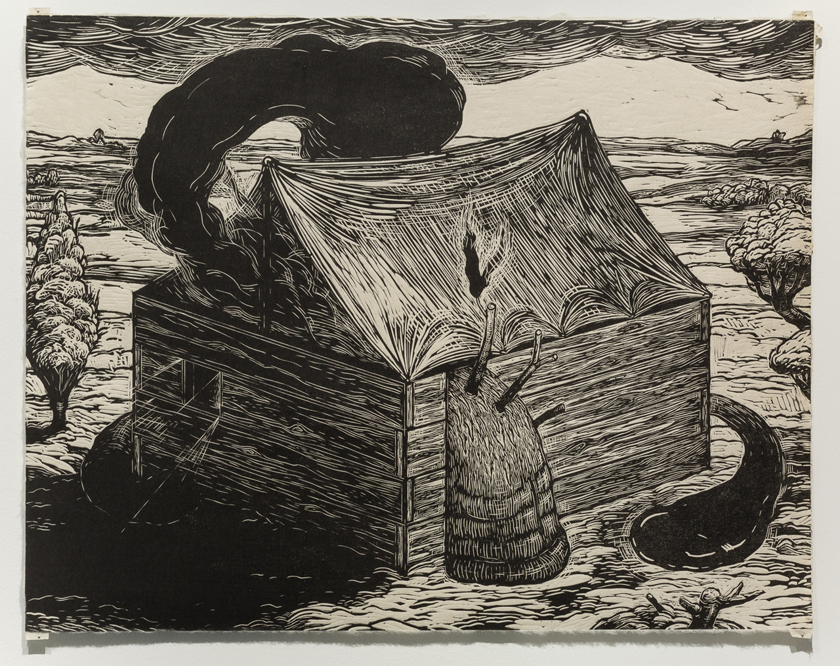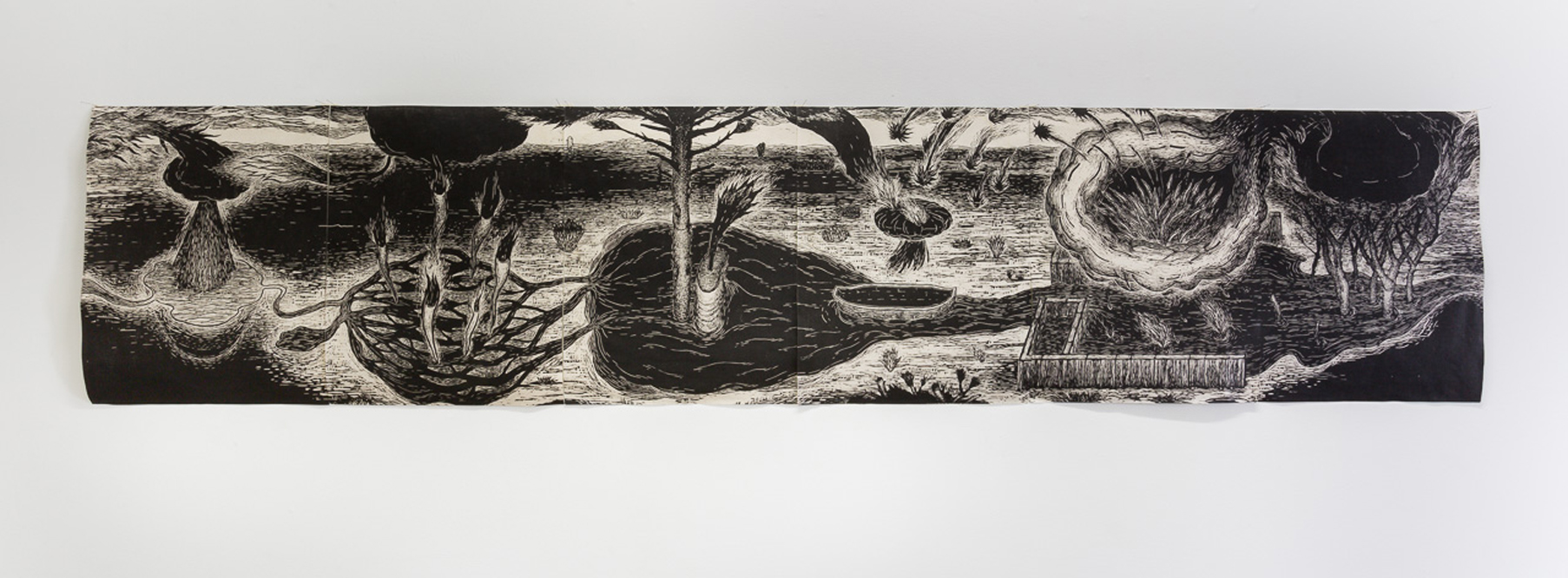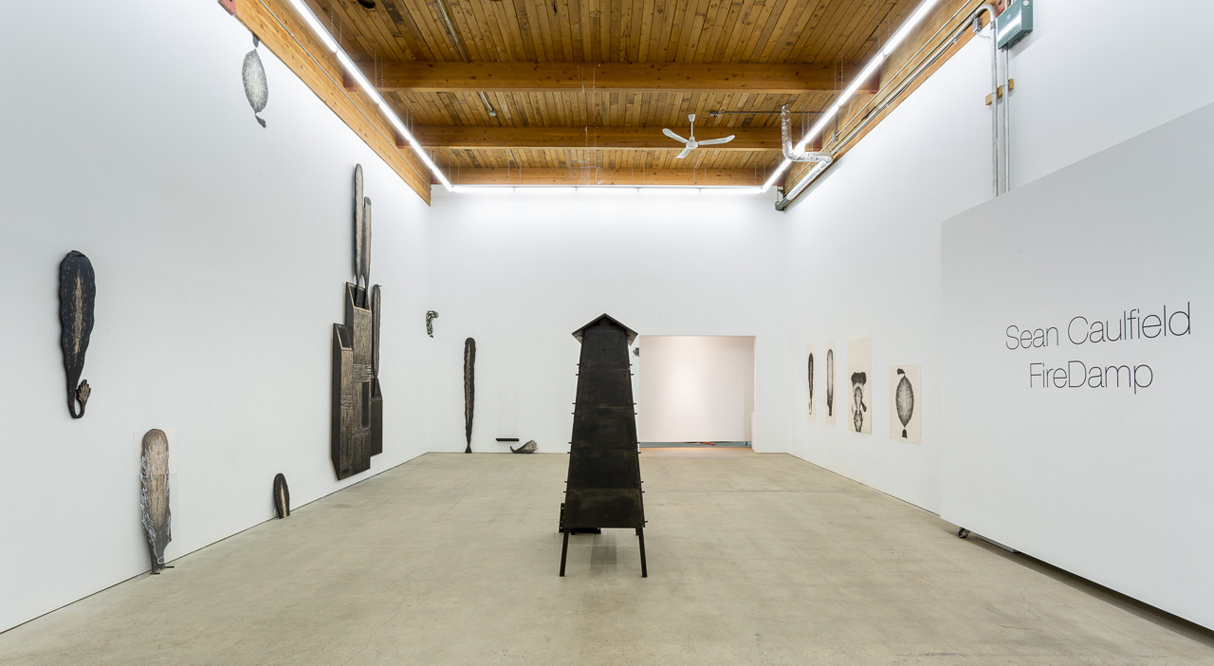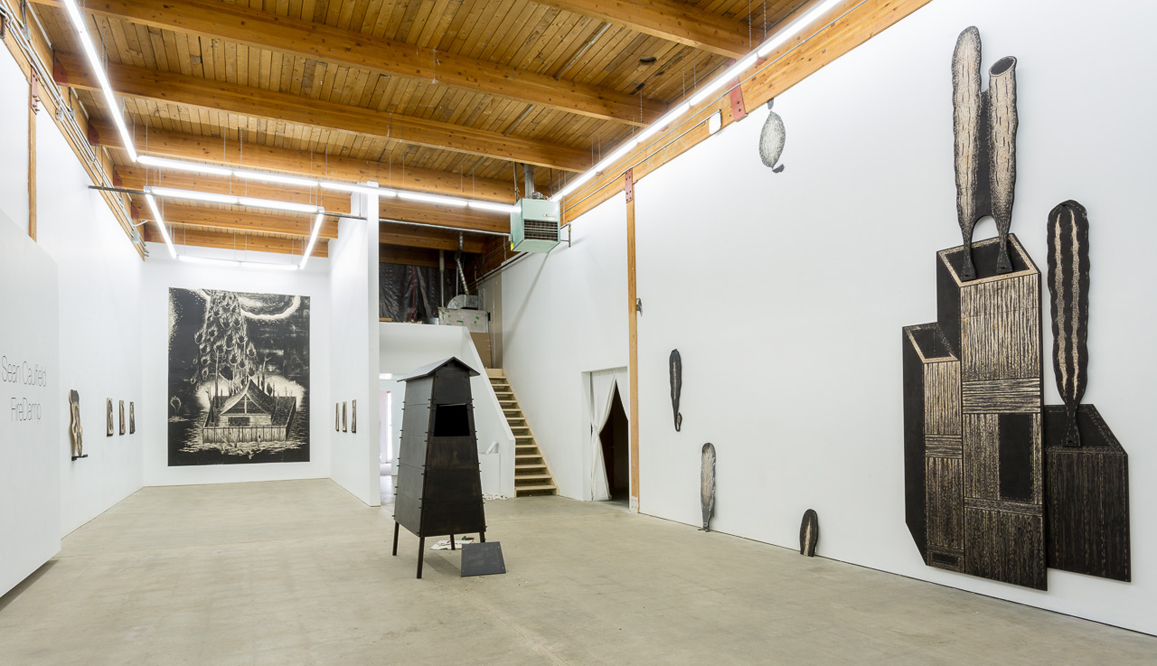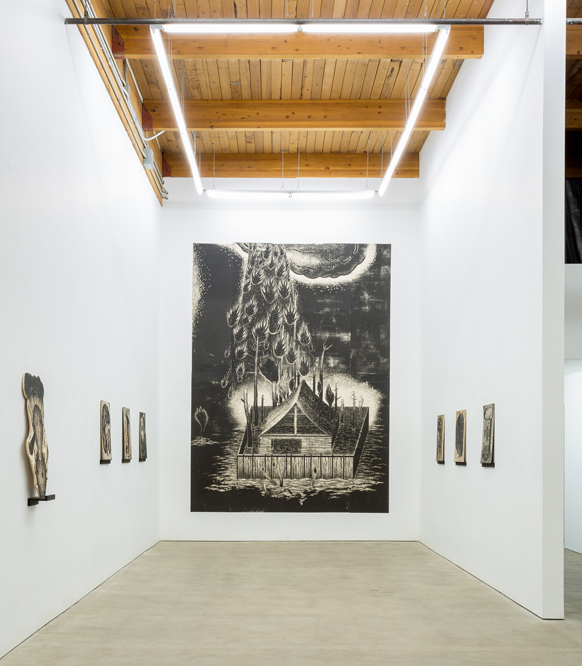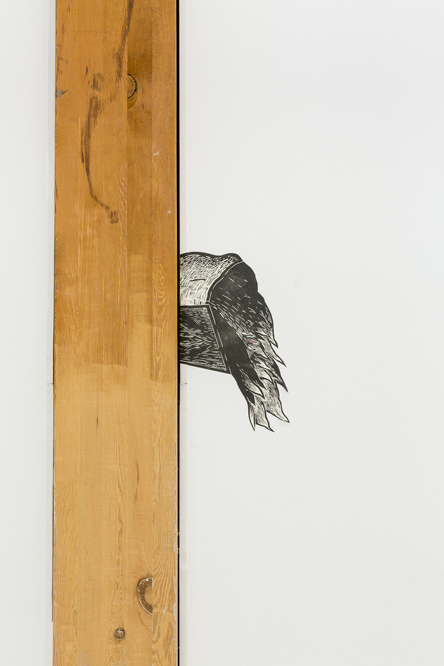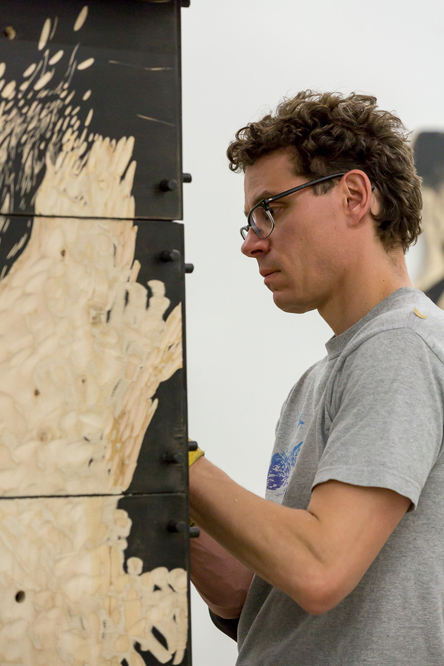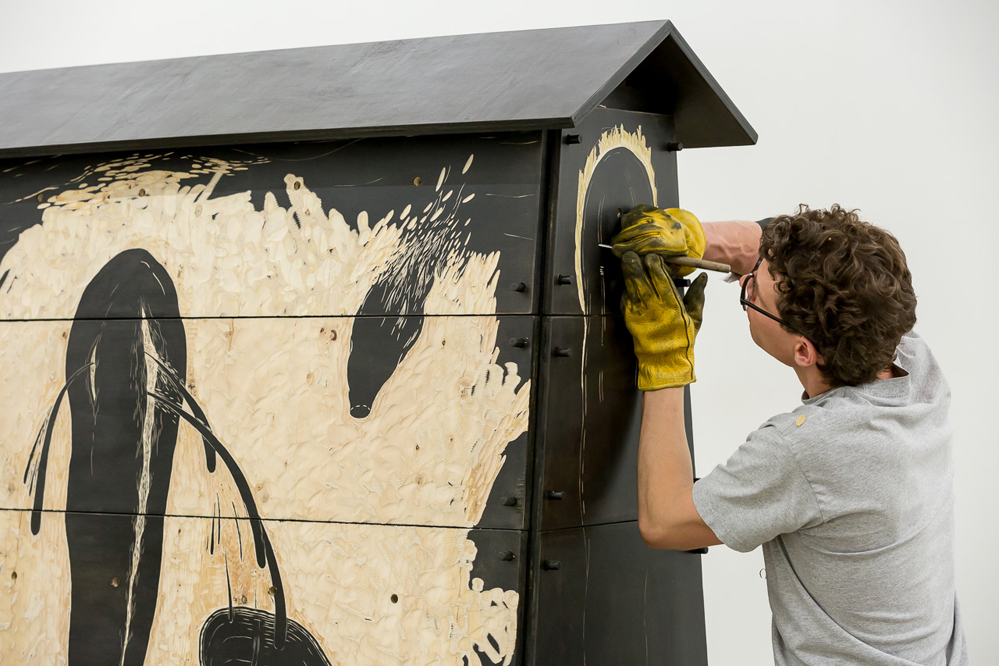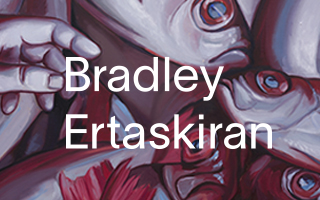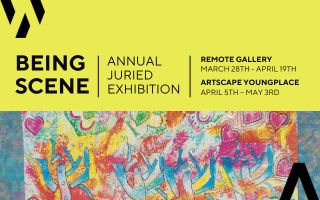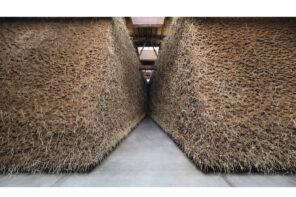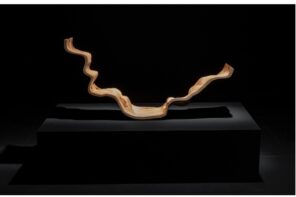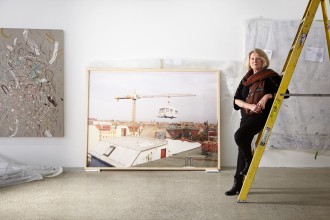Beneath a cloudless, 180-degree sky, the prairie landscape is littered with alien, industrial objects. This is the backdrop of Sean Caulfield’s childhood in rural Alberta, marked by the presence of his father’s oil company.
Now the province’s iconic oil city, Fort McMurray, is engulfed in flames after an unusually dry winter and unseasonably high temperatures, the surrounding forests buckling like tinder. The fire has grown to 420,000 hectares, forcing over 80,000 residents out. It will most likely prove to be Canada’s costliest natural disaster.
Caulfield’s Spring exhibition at Edmonton’s dc3 Art Projects, however, disturbs our anachronistic understanding of what constitutes as “natural,” offering a timely rumination, a happenstance of subject. In FireDamp – a mining term that describes the potential for destruction when environmental processes meet industrial ones – Caulfield’s meticulously crafted black prints and woodblocks depict uncanny ecosystems on the verge of collapse, leaking strange fluids, burning darkly.
Caulfield has contended with fire as a subject before. A collection of his delicately ominous etchings from the early 2000s came together in his artist book Darkfire (2007), resonating as twenty-first-century illustrations of Dante’s Inferno and Purgatorio. In FireDamp, however, fire leaps off the page onto the gallery walls and erupts into the interior space in a purposeful upset. In the middle of a gallery strewn with small and largescale prints and woodblocks, Caulfield has erected an active studio, performing a sculpture throughout the exhibition’s run. This marks a significant shift in Caulfield’s work as he begins to use the woodblock as a deliberate tool to highlight the urgency of human impact on this planet, now literally inscribed into the rocks of our current geologic era.
The situation in Fort McMurray tempts us to recklessly connect the dots. A municipal employee was suspended after tweeting, “Karmic #climatechange fire burns Canadian oilsands city.” Though tone-deaf, the tweet captured a very real anxiety rooted in our inability to map out the realities of our industrialized and globalized present. With FireDamp, Caulfield points to this anxiety by posing a problem: how do we fathom the relationship between these complex and seemingly disparate processes?
Echoing historic anxieties, Caulfield extends the tradition of European woodblock printmaking not just in medium but emotional tenor, too. Where Durer expressed apprehension over the Protestant Reformation through intricate scenes like The Four Horseman of the Apocalypse (circa 1497-98), the German Expressionists, in works such as Emile Nolde’s Prophet (1912), honed in on hopeful figures amid the turmoil of the exterminating onslaught. Caulfield zooms in even further by looking beyond the human subject in our age of oil, where it has become increasingly difficult to locate ourselves in the midst of global forces. Here, human presence is marked only by its traces: shelters, factories, and other man-made objects. Prints like Prairie Siren (2015) depict grotesque organic forms and architectural structures spewing oil-like substances and flames that tear up natural landscapes. Caulfield’s woodblocks, however, force this human presence into the wood itself. They lay bare the labor behind each work – every violence, every hand-carved line working against the wood grain – reasserting the hand of the artist, the damage, the build.
The printmaking process becomes uncomfortably intimate when Caulfield exposes the artist even further with Cloud House, an ongoing experimental sculpture comprised of a set of wood panels arranged into a house-like structure. Like layers of sediment, the work slowly takes shape over time. Watching Caulfield painstakingly carve his mysterious forms into the black-lacquered maple wood, you become enthralled by his obsessive mark-making and acutely aware of its toll on his body. Caulfield admits to me that he worries this performative sculpture might come across like a “how-to” and distract from the content of his work. However, it’s precisely the how-ness of the work that invests viewers in the process behind the work and implicates them beyond mere representation.
Reinforcing the elision of the human subject in his prints, Caulfield invites us to take our place in his titular installation, FireDamp. Made up of several prints and woodcuts, the piece explodes printed scenes into their constituent parts. A multi-layered smokestack reigns over smaller, individual woodblocks and prints of licking flames and floating spore-like forms. This is a world of disconnection where the industrial, though central, lacks the gravitational clout to keep the natural elements in order. Chaos is the guiding principle as Caulfield exaggerates the sculptural quality of his hand-carved woodblocks by printing directly on the gallery wall and haphazardly leaning woodblocks and printed Plexiglas against it. Navigating this expanded print, we become ensnared in the fraught prairie landscape of Caulfield’s childhood, trying to make sense of the looming structures scattered across the expanse.
In his collage approach to the FireDamp installation, Caulfield displays a masterful use of negative space by playing with the gallery wall as both pictorial plane and architectural limit. In drawing attention to the institution’s infrastructure, Caulfield points to what extends beyond it. The exhibition in fact exists in an unruly constellation with his concurrent exhibition at the Art Gallery of Alberta’s Manning Hall, which he worked on while creating FireDamp. Titled, The Flood (2016), the work is the largest Caulfield has created to date: a monumental mural of woodblock panels measuring 30 by 22 feet. Both mythic in scope and content, The Flood maps out a foreboding arc of frenzied flames that leap forth from a fire-making machine only to befall a shelter of sorts, exposing the man-made disaster at the root of the natural. Other iterations of this work, however, destabilize its authority as an organic, self-enclosed object: a partial print produced from the mural can be found wheat-pasted in a metro station in downtown Edmonton as part of that exhibition, while yet another is incorporated into the show at dc3 Art Projects. Each element does not stand alone, but exists in an invisible continuum of competing contexts.
While we struggle to make sense of disasters like Fort McMurray, explanations like “karma” can be disturbingly appealing. How else to make sense of these connections? Rapid, largely invisible environmental change and our infinitely complex political and economic systems have made it impossible to create coherent cognitive maps of our world today. These immense processes defy representation due to their scale and complexity, calling for new strategies of art-making. Caulfield’s expanded concept of print amplifies our sense of being lost by denying the human its privileged, stable place as subject or viewer. We are rather set loose as wanderers, stumbling around the vast prairies of his memory. With our senses attuned to the labor and process behind each given work, however, we soon recognize human tracks not only in the industrial objects but in the so-called natural landscape itself.

